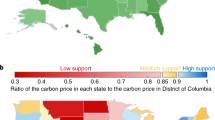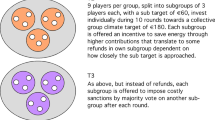Abstract
The third Conference of the Parties in Kyoto set the target of reducing greenhouse-gas emissions by an average of 5.3% with respect to 1990 values by 2008–2012. One of the main objections to the protocol's ratification is that compliance would pose an unbearable economic burden on the countries involved1. But we show here that this is not the case if costs apart from the direct costs of energy production are also considered. Costs are also incurred in rectifying damage to human health, material goods, agriculture and the environment related to greenhouse-gas emissions.
This is a preview of subscription content, access via your institution
Access options
Subscribe to this journal
Receive 51 print issues and online access
$199.00 per year
only $3.90 per issue
Buy this article
- Purchase on Springer Link
- Instant access to full article PDF
Prices may be subject to local taxes which are calculated during checkout

Similar content being viewed by others
References
Remarks by President G. W. Bush on Global Climate Change (Office of the Press Secretary, The White House, 11 June 2001).
De Leo, G. A., Rizzi, L. & Caizzi, A. in Proc. 29th Int. Conf. Automation and Decision Making 247–256 (FAST, Milan, 2000).
Callan, S. J. & Thomas, J. M. Environmental Economics and Management: Theory, Policy and Applications (Irwin, Chicago, 1996).
De Paoli, L. & Lorenzoni, A. Economia e politica delle fonti rinnovabili e della cogenerazione (Franco Angeli, Milan, 1999).
IEA/OECD Experience Curves for Energy Technology Policy (IEA, Paris, 2000) (http://www.iea.org/public/studies/curves.htm).
European Commission ExternE: Externalities of Energy Vols 1–6 (EC, Brussels, 1995) (http://externe.jrc.es/index.html).
Rowe, R. D. et al. ESEERCO, New York State Environmental Externalities Cost Study Vols 1, 2 (Oceana, New York, 1995).
Russell, L. (ed.) External Costs and Benefits of Fuel Cycles (Oak Ridge National Laboratory and Resources for the Future, Oak Ridge, Tennessee, 1994).
Gatto, M. & De Leo, G. A. Bioscience 50, 347–355 (2000).
Interlaboratory Working Group Scenarios for a Clean Energy Future (Oak Ridge National Laboratory, Tennessee, and Lawrence Berkeley National Laboratory, California; OPRNL/CON-476 and LBNL-44029, 2000).
Author information
Authors and Affiliations
Corresponding author
Supplementary information
The general structure of the optimisation problems we have solved is as follows:
Min f(C(x)/q)
xmin £ x £ xmax
0£ g(x) £ a
where f(C) is a suitable function of the costs to be considered in the specific problem (BAU, MSC, BAU+Kyoto), x is the vector of decision variables (namely, TWh/yr contributed by each production technology to satisfying the electricity demand), q is the vector of parameters (such as different costs per kWh for the different technologies) defining the objective function f, while xmin £ x £ xmax and 0 £ g(x) £ a are the constraints. More precisely, the first set of bounds "xmin £ x £ xmax" defines the technological constraints for the decision variables with xmax being the maximum feasible quotas estimated for each technology as of 2010 and xmin being the minimum quotas (e.g., hydroelectric power plants that are currently operational will still be operational in 2010). The second set of bounds "0 £ g(x) £ a" defines additional constraints, which are functions of the decision variables; it always includes the mandatory constraint that the sum of the decision variables be equal to 353 TWh/yr, which is the electricity demand for Italy in 2010. This demand has been estimated from the results of many extensive studies carried out by the largest electricity producer in Italy1 (ENEL), the Italian Oil Association (Unione Petrolifera), the government2, the research institution Ente Nazionale Energie Alternative (ENEA), and other researchers3. Also, this second set of constraints may contain ceilings to emissions to satisfy the Kyoto protocol (in the BAU+Kyoto scenarios).
The function f is built by summing up all the costs: in BAU and BAU+Kyoto it includes only the discounted (10%) and annualised investment costs, the cost of fuel and the operating costs, while in MSC it comprises the external costs too. A more complete account of the methodology is given by De Paoli and Lorenzoni4. Information on the constraints, the industrial and local external costs, and the emissions is reported in Table 1.
As for external costs, we have adopted the definition of the ExternE project. Global External costs are those due to GHG. As they are affected by a great level of uncertainty, ExternE has decided to account separately for global external costs and "non-global" external costs, which are referred to as "local". So, "local" external costs are all those due to causes different from Global Climate Change. As a consequence, local external costs do not necessarily have to be very localized geographically, even though they mostly reflect damages occurring within Italy. In fact, the Ecosense software package used in ExternE implements both a small scale air pollution model (ISC) and a regional air quality model (the Harwell Trajectory Model) to compute diffusion of pollutants at the European level. In Table 1 we report, for each technology, the average local external cost per unit of energy produced and its range of variation as estimated from the comprehensive work by De Paoli and Lorenzoni4.
To generate the box and whiskers plots shown in Figure 1 of the main text we have used a Monte-Carlo approach. In fact, to account for uncertainty in the cost estimates, we have fitted beta distributions to data on industrial and local external costs. Then, we have drawn industrial and local external costs at random from the beta distributions and solved the corresponding optimisation problems (via Linear Programming) 1000 times, while keeping the global external cost set to 30 Euros per tonne of CO2. The corresponding shares of each kind of power-production technology are shown in Table 2. It is interesting to note that in general the shares are much less sensitive to changes in the cost estimates than the corresponding values of the objective function f. The largest variations are for the use of gas and oil in the BAU scenario. To test for the significance of differences in the costs shown in Figure 1 of the main text we have used a randomisation test. All the pairwise differences of industrial, external and total costs turn out to be significant (P = 95%).
As the global external costs are most uncertain we have run a sensitivity analysis for the solution of the MSC problem with the cost per tonne of CO2 ranging between 0 and 250 Euros and the other costs set to their averages. The results are reported in Figure SuppInf. If we set the global external cost to zero, MSC is equivalent to minimising the sum of the industrial costs and the local external costs alone. Even in this case the MSC scenario implies lower total costs than BAU, with a net saving of about 918 million Euros per year, as the increase of industrial costs (+548 million Euros) is more than compensated by the decrease of local external costs (-1466 million Euros). Further analysis shows that in both MSC and BAU+Kyoto scenarios net savings with respect to BAU are larger and larger (in percentage and in absolute value) for increasing anticipated damages of global climate change, as the decrease of total external costs always largely overcompensates the higher industrial costs required to shift toward cleaner technologies. As for the share of different technologies, MSC implies a strong shift towards gas even when global external costs are set to zero, as reported in Figure SuppInf. The share of renewable sources equals 16.6%, that of cogeneration 17.9% and both do not change appreciably as long as the global external cost per tonne of CO2 is lower than 30 Euros. For larger costs per tonne of CO2, the importance of cogeneration increases to 20%, the share of renewables reaches 23.6% while that of gas decreases to 59.6%.
-
1
ENEL Dati statistici sull’energia elettrica in Italia (ENEL, Roma, 1998).
-
2
CIPE Libro bianco per la valorizzazione delle fonti rinnovabili (Italian Government, Roma, 1999). Also available on Internet at URL: http://mica-dgfe.casaccia.enea.it/Studi/librobiancocipe.htm.
-
3
Gullì, F. Politica ambientale e cambiamento tecnologico: Lo sviluppo della nuova generazione (Egea, Milano, 1999).
-
4
De Paoli, L. & Lorenzoni, A. Economia e politica delle fonti rinnovabili e della cogenerazione (Franco Angeli, Milano, 1999).

Table 1
(PNG 6.71 KB)
Feasible production quotas, costs and GHG emission for each technology of electricity generation in Italy. Green: renewables, red: oil, blue: gas, black: coal.

Figure S1
(GIF 6.71 KB)
Sensitivity analysis of the MSC scenario with respect to global external costs. For increasing costs, the best strategy is to favour first gas, then co-generation and finally, for high global costs, renewable sources.
Rights and permissions
About this article
Cite this article
De Leo, G., Rizzi, L., Caizzi, A. et al. The economic benefits of the Kyoto Protocol. Nature 413, 478–479 (2001). https://doi.org/10.1038/35097156
Issue Date:
DOI: https://doi.org/10.1038/35097156
Comments
By submitting a comment you agree to abide by our Terms and Community Guidelines. If you find something abusive or that does not comply with our terms or guidelines please flag it as inappropriate.



